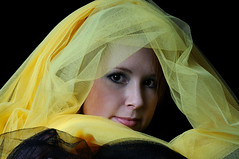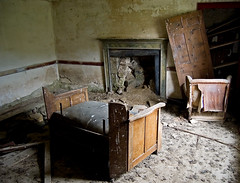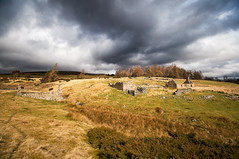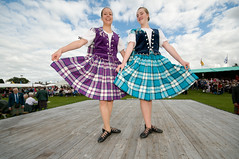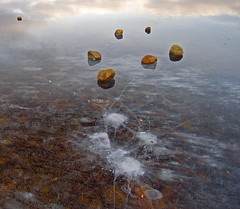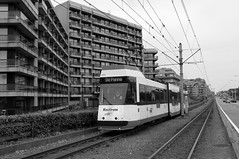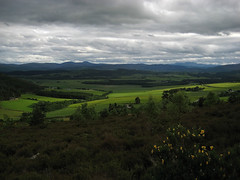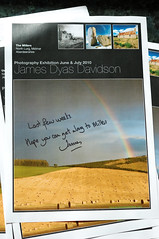A wee taster of the photo shoot I did with Paul a few weeks ago.
Due to holidays and going back to work with a bang, it is only now that I can share some of them with you. Hope you like them and I'm open to your thoughts as I'm not normally a portrait photographer and I don't have a studio or studio lights. We enjoyed doing them!
Paul was happy for me to take some shots knowing I didn't have any studio lights or a studio. I got some black curtains and rails from Argos and put them on the wall and on the floor. Just in front of Paul is a white sheet to reflect some light up. I set up a SB600 off camera to the left and a small reflector to the right. Some natural light came in from the left. We knew we were going to do something with the fiddle suspended and Paul would be in full kilted dress, so it a bit traditional and a bit fun.
Please tell what I should do to improve as inside portraits is not my normal shoot.
Try it bigger.
Sunday, 31 October 2010
Monday, 27 September 2010
My first experience of using a studio and a model
I went to Elgin Studios last weekend to learn about studio lighting and shooting with a model, in this case Claire Emson. The instructor was David Porter who clearly knows his stuff. I, on the other hand knew nothing about using a studio or using a model. David set up the lighting for this shot, so please don't praise me for that. All I tried to do was use the props and get Claire to pose, take a shot that was exposed well enough.
I would love some real constructive comments on this shot as I discovered that I didn't have what might be called a natural flare with posing models - in fact I was crap at it. It was my first real experience of doing it and I'm sure I would get better at it if I did it more. I didn't shoot enough and left too much time in between shots which meant Claire lost her momentum of posing and wondered what I wanted as I wasn't taking any shots. So that's a lesson learned.
I felt a bit awkward as I suppose I'm a landscape photographer generally and when I walk about looking at a beautiful Aberdeenshire landscape, I decide which part of the chaos I'm going to frame and wait for the correct light. With studio shots using models, the lights are in your control, background (and foreground) is in your control and there is no chaos to frame, there a model standing in front of you. Yes, you deicide about how much of the model you're shooting but the real skill I think (as well as getting the lighting correct) is what you do with the model (or what she gives you).
Anyway, that's some initial thoughts.
I would love some real constructive comments on this shot as I discovered that I didn't have what might be called a natural flare with posing models - in fact I was crap at it. It was my first real experience of doing it and I'm sure I would get better at it if I did it more. I didn't shoot enough and left too much time in between shots which meant Claire lost her momentum of posing and wondered what I wanted as I wasn't taking any shots. So that's a lesson learned.
I felt a bit awkward as I suppose I'm a landscape photographer generally and when I walk about looking at a beautiful Aberdeenshire landscape, I decide which part of the chaos I'm going to frame and wait for the correct light. With studio shots using models, the lights are in your control, background (and foreground) is in your control and there is no chaos to frame, there a model standing in front of you. Yes, you deicide about how much of the model you're shooting but the real skill I think (as well as getting the lighting correct) is what you do with the model (or what she gives you).
Anyway, that's some initial thoughts.
Tuesday, 7 September 2010
What I decided whilst in hospital regarding me and photography. Part 3
I have decided to remain a hobbyist photographer who will shoot mainly local Historical sites and abandoned communities. Will I be bothered then if there is no interest or enjoyment from my pictures? The answer should be no because I will be shooting what I’m passionate about and I should be fulfilling my creative urges. But in reality, we humans like to get some encouragement and praise - don’t we? We tend to trust the people who are like us so if people who have an interest in local History and/or abandoned communities see that I too have that interest, then perhaps I will have an audience for my work. It is like serving a market where you are already an ‘insider’, so it should help me empathise with that market.
The question ‘Am I good enough?’ will come up. A question like that will never be answered probably, and self doubt can be the motivator to improve one’s craft. I will be (and have been) dogged by such a question but I know that all I can say is, I’m getting better, I’m improving but will fall short of being ‘good enough’ because I will always want to be better. Talent is not easily evaluated or quantified.
I need to tackle and focus more on questions like ‘Am I willing to work hard at learning my craft?’ ‘ Am I willing to research and learn and make mistakes?’ ‘Am I willing to put my work under scrutiny of my peers so I can improve?’ ‘How passionately do I want this?’
I have to accept the fact that highly talented photographers may not need to work so hard as less talented photographers. That said, how do we know how much work someone has put into their craft? Why do we tend to think ‘they got lucky’ or ‘it was handed to them on a plate’? I need to always assume they have worked hard to get where they are. For me, bold steps are needed. Some interests and activities may need to jettisoned or at least cut down.
High quality, technically perfect but mediocre photography is everywhere now and organisations have a vast quantity to choose from, and at the best price - free! I don’t know if I can rise above this but I’m going to try and recent deals with publishers and record companies and a solo exhibition success has given me some encouragement. However, marketing knowledge will now take a back seat to honing my craft. I want to be a good photographer. I want to produce images that people like and get pleasure from and that is why, for the meantime, I will remain a hobbyist photographer.
Taken from Visionmongers by David duChemin.
Monday, 6 September 2010
What I decided whilst in hospital regarding me and photography. Part 2
So I’ve decided to shoot what I love and learn my craft. Also, I can see that I will probably not be a professional photographer. Why not?
I like my day job and it can fund my hobby.
I can shoot what I want.
I can create when I want to - when I’m inspired and when I feel it is the right time. Only financially secure and successful professional photographers can do that as well as complete commercial work I would imagine.
I can love my photographs, get opinions on my work without feeling my work sucks just because nobody buys it/wants it. I can feel like a ‘real’ photographer without having to have people buy my work.
In truth, maybe I’m just not willing to do all the hard work that is needed to become a successful professional photographer (and to some extent to sacrifice my passion for commercial reasons). I’ve put my creative urges to one side for too long and it is now or never for me to pursue my creative vision.
Hobbyist or professional, a photographer should know who they are and what they have to offer. I need to ask myself which shots gave me the most satisfaction and is there a pattern? I have studied and taught History for many years now and local History, namely abandoned settlements, is still an big interest to me. I’ve been told that I have captured the spirit and essence of these abandoned places. Whether that is true or not, I’ve certainly felt the toil, hardships, relationships and tragedies of these places. I enjoy researching these places beforehand, planning the route, finding the remains and, if possible, enter these premises. The real challenge is trying to get an interesting shot which conveys the drama and remoteness of these abandoned communities.
More of my time will have to be spent honing the skills of my craft. I’m still not there when it comes to getting the exposures right. I can still screw it up and wonder why it screwed up. Also, my processing and printing needs more of my attention. I will probably never be one of these Photoshop experts who spends hours and days on one shot, but I could make small (and continue to make small) improvements to my processing and workflow.
To be continued. Taken from Visionmongers by David duChemin.
Sunday, 5 September 2010
What I decided whilst in hospital regarding me and photography. Part 1
I will buy the best camera and lens I can afford but acknowledge that it will not make me any more creative or talented. Photography is a craft that can take years to learn and get better at. Gear can just help with that craft. It takes hard work to be good at something - accept that and work harder at it. Stop relying on gear and start trusting my vision and loving the act of putting the world into a frame.
I will probably not get to where I’d like to be - or where I think it is. That is, the life of a professional photographer is not what I think it is. I guess it is the journey not the destination that’s important. As a hobbyist photographer, I seem to have so little time to learn, take shots, process shots, attend courses, read books, see exhibitions, etc., so it must be even more difficult for a pro as they have so many other ‘business’ issues to deal with (and, in the current climate, worry about).
If I was serious about becoming a professional photographer, it would be to take the shots I want to take and hopefully make some money doing it. So it is about being creative and expressing myself really, not becoming rich and famous. But would there be a market for what I shoot? If not, then I wouldn’t make money, so take the shots that make money? No. My original goal would then be lost. So it is all about ‘what do I want?’
If the point was to just make money, then I would be much, much better off staying in the rewarding job I’m currently in. I love photography, so doing it professionally could in fact suck the life from it if I went the ‘Weddings, pets and babies’ route. It is so true what they say - shoot what you’re passionate about. I will still try shooting stuff outwith my ‘comfort zone’ but just for the sake of learning.
I’m focused again.
To be continued. Taken from Visionmongers by David duChemin.
Thursday, 12 August 2010
Keep Learning
I was asked to be one of the photographers at the recent Aboyne Highland Games. Trying to capture the best of highland games is not easy as there is so much going, often at the same time and at different parts of the field (much the same as any games). Also, it was my first experience of doing a shoot at a games, so along with the question of what to shoot, was the question of how to shoot. I decided to stay on Raw and mostly on Aperture priority. It was a changeable day weather wise, and to try to reduce complex backgrounds, I was often shooting from ground level and getting much sky, making the exposure too dark. In future, I would just shoot getting the background as blurred as possible or completely over expose the sky.
I also shot in continuous mode a few times. I rarely do this and, though a simple thing to do, I was pleased with the camera's continuous auto-focusing. It uses up too much memory though and much deleting afterwards is needed. There was one sequence I thought I would use to try to learn how to make an animated Gif in Photoshop Elements (hence the title of 'keep learning'). It was more time consuming than difficult and then you find sites like Flickr don't support them, (although there is a work around) so why bother?
I also shot in continuous mode a few times. I rarely do this and, though a simple thing to do, I was pleased with the camera's continuous auto-focusing. It uses up too much memory though and much deleting afterwards is needed. There was one sequence I thought I would use to try to learn how to make an animated Gif in Photoshop Elements (hence the title of 'keep learning'). It was more time consuming than difficult and then you find sites like Flickr don't support them, (although there is a work around) so why bother?
Sunday, 8 August 2010
Dancers, Aboyne Highland Games
You can read the manuals and books as much as you like - the best way to learn is by doing. I was one of the official photographers at the Aboyne Highland Games today. It was a long (10.30-6.30) but enjoyable day. Weather stayed dry but cloudy with glimpses of sun - this was one shot during such a glimpse. (If I remember correctly, these girls won a prize for the best outfits, as did some other girls but had gone. Look great don't they?)
What did I learn?
A zoom lens would have been good but I didn't miss it as much as I thought (I used my 24-70 on a non-full sensor D300 which gives me something like 35 - 110mm). I was able to get close to the action.
Backgrounds are an issue. It's messy and distracting, so there was lots of kneeling down, pointing up and then having to deal with exposures pointing up into the sky.
I went the opposite way and stuck on my 10-20mm wide and got some different shots which got a good overall feel to the day.
Continuous shooting is not something i use much but did at these games. Great for capturing those hammer throws etc but cards fill up too quickly and then time is wasted deleting the ones that are useless.
Auto-focusing isn't as good as the manufacturers make out. Continuous tracking focus? Well, maybe I need to be shown how it works but I wasn't impressed.
It's sore on the back and legs, so I would take one camera, one of those wide range zooms, 70-200, and the 24-70, memory cards and battery pack.
What did I learn?
A zoom lens would have been good but I didn't miss it as much as I thought (I used my 24-70 on a non-full sensor D300 which gives me something like 35 - 110mm). I was able to get close to the action.
Backgrounds are an issue. It's messy and distracting, so there was lots of kneeling down, pointing up and then having to deal with exposures pointing up into the sky.
I went the opposite way and stuck on my 10-20mm wide and got some different shots which got a good overall feel to the day.
Continuous shooting is not something i use much but did at these games. Great for capturing those hammer throws etc but cards fill up too quickly and then time is wasted deleting the ones that are useless.
Auto-focusing isn't as good as the manufacturers make out. Continuous tracking focus? Well, maybe I need to be shown how it works but I wasn't impressed.
It's sore on the back and legs, so I would take one camera, one of those wide range zooms, 70-200, and the 24-70, memory cards and battery pack.
Wednesday, 4 August 2010
Scottish Emigrant
Still from a video shown at the National Museum of Scotland about Scottish emigrants to Australia. I just grabbed a shot - ISO 3200; f2.8; 1/250s.
I'm very interested in Scottish emigration from the push and pull reasons for why they left to the experience of the journey to each story of how they got on in their new lands. But what is also fascinating is the heritage and culture they have installed in their new countries. What I can actually photograph is what has been abandoned back home, here in Scotland, from the decayed houses and ghostly silent communities to the heritage remnants.
I'm very interested in Scottish emigration from the push and pull reasons for why they left to the experience of the journey to each story of how they got on in their new lands. But what is also fascinating is the heritage and culture they have installed in their new countries. What I can actually photograph is what has been abandoned back home, here in Scotland, from the decayed houses and ghostly silent communities to the heritage remnants.
Sunday, 1 August 2010
You can try to break me, but I will remain beautiful.
This is, according to Flickr is my most popular and most interesting picture. It got to the front page of Explore. I was regularly getting pictures into Explore, but since I've become busier with my photography (and I think better at it), I don't spend so much time on Flickr and consequently less shots get into Explore. Does this mean anything? Do I suck? Or is getting a picture into Explore just some kind of 'pat on the head' to say 'good boy' for participating on Flickr?
Tuesday, 27 July 2010
Judy
A promo shot for her business. Done in about 10 minutes at home. One SB600 and a reflector. It did the job and was used in her literature for her business.
I'm sure strobists could rip this apart but at the moment, that is the sum total of my lighting equipment! I'm going to attend a studio lighting course soon and I will decide when and in what way, I'll embrace studio work. So far I've tended to go and find the light, not create it, but I'm getting more requests to do work that requires lighting and more control of the light. More stuff to learn but they say you should always keep learning don't they?
I'm sure strobists could rip this apart but at the moment, that is the sum total of my lighting equipment! I'm going to attend a studio lighting course soon and I will decide when and in what way, I'll embrace studio work. So far I've tended to go and find the light, not create it, but I'm getting more requests to do work that requires lighting and more control of the light. More stuff to learn but they say you should always keep learning don't they?
Monday, 26 July 2010
Workflow?
Over the last couple of days I've been trying to get back on top of my photo files, back-ups and photo logs. It got in a bit of a mess, very much to my surprise, quite quickly. I'm usually very disciplined when it comes to this sort of thing but after a few photo shoots, a trip abroad and deadlines, things piled up.
Part of the reason for the mess is I'm partly working on a MAC to see if it better than a PC, so the files get a bit mixed up.
My 'workflow', if I have the correct understanding of that word, goes something like this:
Shoot in RAW; upload files to PC and copy straight to CD-Rs. Files set up by date as RAW, TIFF&JPegs.
I chose a shot to work on, converting in ViewNX to a TIFF file. Usually there is not much done to the shot after that, but if anything is needed then I still use Elements 5 or 6 for the MAC.
This shot is filed as V.1 and as smaller resolution one as a Jpeg, filed as 'web'.
Once I've processed all the shots I want to do, I 'close' the file by renaming it '[Date} All Done' This completed file is then copied onto a DVD and is sent to two external hard-drives.
What's your thoughts on this 'workflow' and what is yours?
Part of the reason for the mess is I'm partly working on a MAC to see if it better than a PC, so the files get a bit mixed up.
My 'workflow', if I have the correct understanding of that word, goes something like this:
Shoot in RAW; upload files to PC and copy straight to CD-Rs. Files set up by date as RAW, TIFF&JPegs.
I chose a shot to work on, converting in ViewNX to a TIFF file. Usually there is not much done to the shot after that, but if anything is needed then I still use Elements 5 or 6 for the MAC.
This shot is filed as V.1 and as smaller resolution one as a Jpeg, filed as 'web'.
Once I've processed all the shots I want to do, I 'close' the file by renaming it '[Date} All Done' This completed file is then copied onto a DVD and is sent to two external hard-drives.
What's your thoughts on this 'workflow' and what is yours?
Wednesday, 21 July 2010
Tram, Nieuwpoort Belgium
John Szarkowski (director of photography at New York's’ Musuem of Modern art) in 1976, designated photographs as mirrors or windows. The ‘window’ photo was one in which the subject matter is of primary importance, a scientific record for example, and the view of the photographer secondary. The ‘mirror’ was the opposite, the photo existing mainly to reflect the photographer’s viewpoint, a self-conscious ‘art’ photo, for instance.
A useful distinction but most photographs are both mirrors and windows.
From The Genius of Photography by Gerry Badger.
A useful distinction but most photographs are both mirrors and windows.
From The Genius of Photography by Gerry Badger.
Friday, 16 July 2010
Alasdair Fraser, Bruce Molsky and Natalie Haas
I'm still buzzing after an amazing concert at the Woodend Barn in Banchory. A concert with the very best of fiddlers and dancers from Scotland and beyond, featuring Alasdair Fraser and Natalie Haas (Scotland and USA), with Bragod (Wales), Boreas (Norway and Scottish Borders), Göran Premburg, Pernilla Stendahl, Gill Redmond, Mats Nilsson and Ingegerd Sigfridsson (Sweden and England), Caoimhín Ó Raghallaigh (Ireland), Bruce Molsky and Nic Gareiss (USA), the Aberdeen and Banchory Fiddlers (Scotland). It was 100% talent - none of your divas, charlatans or hacks of today. Well done NAFco for organising such a wonderful night - all for £10 too!
www.abdn.ac.uk/nafco
I wanted to share with you what I did to take these shots. I'm not experienced in taking concert shots at all and didn't want to use a flash which I think is really off putting for the performers. I also didn't want lug the heavy D300 with the 24-70mm lens so took the D50 with the great 50mm f1.8 lens. I knew I didn't want the shutter speed slower than 1/60 so set the camera to shutter priority at that. I then set up auto ISO in the menu so that the camera controlled not only the aperture (which stayed pretty much at f1.8 anyway) but the ISO as well. What is interesting is the ISO values that appear. This one for example is 560 ISO. Interesting eh?
www.abdn.ac.uk/nafco
I wanted to share with you what I did to take these shots. I'm not experienced in taking concert shots at all and didn't want to use a flash which I think is really off putting for the performers. I also didn't want lug the heavy D300 with the 24-70mm lens so took the D50 with the great 50mm f1.8 lens. I knew I didn't want the shutter speed slower than 1/60 so set the camera to shutter priority at that. I then set up auto ISO in the menu so that the camera controlled not only the aperture (which stayed pretty much at f1.8 anyway) but the ISO as well. What is interesting is the ISO values that appear. This one for example is 560 ISO. Interesting eh?
Wednesday, 14 July 2010
Updated my website

Added another set to my website tonight. The Glenbuchat and Strathdon pictures continue my project on abandoned communities in Aberdeenshire. The picture above forms part of the set. Check it out.
It is coming up to a year since I decided to pay Photium to have this website. It cost me £80 for the year and I did sell a couple of pictures through the site which just about covered that outlay. But overall, I don't feel the site does much to promote me as a photographer. If you Google JamesDyasDavidson, this FREE blog seems to come up first, not the website. I suppose it adds to the 'social networking'/Web2.0 idea of promoting your work, but I think my money could be better spent. Anyway, 24 days left to decide if I will continue using Photium. Any thoughts?
Monday, 12 July 2010
Howe of Cromar from Slack
I think Chase Jarvis has a point. Went for walk the other night and just had the wee P&S Canon Ixus70. Pleased with the way this came out. Has some real depth to it.
The idea was to constantly record just stuff in my daily life with this camera (I don't own an iPhone) and shove them on my Facebook page. I started off well but I realised I was taking pictures but not removing them from the card. I'll try harder.
The idea was to constantly record just stuff in my daily life with this camera (I don't own an iPhone) and shove them on my Facebook page. I started off well but I realised I was taking pictures but not removing them from the card. I'll try harder.
Saturday, 10 July 2010
Lucy
This is the lovely Lucy and I took these shots way back in May using whatever I could find at home to make backdrops, one SB600 speedlight and one reflector. My wife Yvonne was there to help Lucy with clothes and jewellery(none of which you can see here!). It was a great experience and I learned a lot and became a bit more confident in dealing with poses as Lucy was so cooperative and willing. The feeling when you look through the viewfinder and you see a gorgeous woman posing so professionally and the light is (nearly) right is quite something. You realise you are not looking at someone else's photo - this is a shot YOU are about to take. A real buzz. More can be seen on my Flickr page.
I did a few fashion shoots for The Millers and boy, do the photos pile up quickly! I work full time and I was doing all of this in my free time so the processing soon fell behind. Anyway, I'm now on holiday and catching up. However, I do need to think about how I can speed up my workflow. Any tips?
I did a few fashion shoots for The Millers and boy, do the photos pile up quickly! I work full time and I was doing all of this in my free time so the processing soon fell behind. Anyway, I'm now on holiday and catching up. However, I do need to think about how I can speed up my workflow. Any tips?
Thursday, 8 July 2010
I guess the higher you want to go, the greater the obstacles.
I'm on holiday just now and an opportunity (in between chores) to try to take my photography to the next level, if you get my meaning. Well tonight I hit the all too familiar feeling of 'Oh My God, I know nothing! I have SO much to learn! I so suck at this photography lark!' For example, I want to learn more about light and using flash, so, the best place to go would be strobist.com which I duly went to and very quickly realised how much I need to get, to learn, to do, to read, to watch, etc. etc. One website seems to lead you hundreds of others - where do you start? where do you stop? Argh! The wealth of info on the web is, on one hand just so fantastic and helpful, but on the other it can be almost paralysing.
Time - there just isn't enough of it.
Advice - there is just too much going around. Some scare you - "Your pictures should stop me dead in my tracks, everytime." An Art dealer/buyer. "You should take pictures of things no one else has taken"!!
And what have I NOT done today? Yip, taken a picture. I think that is what I should focus on more. (excuse the pun)
Any views on my grumble?
Time - there just isn't enough of it.
Advice - there is just too much going around. Some scare you - "Your pictures should stop me dead in my tracks, everytime." An Art dealer/buyer. "You should take pictures of things no one else has taken"!!
And what have I NOT done today? Yip, taken a picture. I think that is what I should focus on more. (excuse the pun)
Any views on my grumble?
Wednesday, 7 July 2010
Last few weeks!
My first solo exhibition finishes at the end of July so if you're in the area and can get along to Millers (which has a restaurant, gifts, deli, books, clothing etc.) I would be delighted. I'm looking for some comments on the exhibition too, good and bad! Go to www.jamesdyasdavidson.com for more.
Sunday, 4 July 2010
Thomas Carlyle by Julia Margaret Cameron
I went to Aberdeen Art Gallery to see the exhibition of photographs by Roger Fenton and Julia Margaret Cameron yesterday and was, yet again, taken by this one of Thomas Carlyle. It is a very blurry, out of focus shot but it has an impact and resonates, especially if you know something about Carlyle. Anyway, this is my contribution to blurry photographs in respect to these pioneering Victorian photographers.
There is also a room full of George Washington Wilson photographs of the royals at Balmoral with nothing better to do than to dress up and recreate scenes from mythology or the Bible and summon Wilson, by telegram, to get himself over to Balmoral and take a few pictures. Fascinating.
There is also a room full of George Washington Wilson photographs of the royals at Balmoral with nothing better to do than to dress up and recreate scenes from mythology or the Bible and summon Wilson, by telegram, to get himself over to Balmoral and take a few pictures. Fascinating.
Thursday, 1 July 2010
You have 4 weeks off work - what would you do to improve your photography?

If you had the following 4 weeks off work, what would you do to move your photography to the next level?
I intend to know every nook and cranny of my camera and all the other pieces of equipment I've bought recently; to take the shots that have, until now only existed in my head; to study more art and photographers; to complete a project that will, yet again take me into an area I'm not familiar with; do more portraits; understand light and flash better; and last but perhaps most importantly of all, take photographs, be creative and fun.
Sunday, 25 April 2010
Inspiration - Part 2

Inspiration - Part 2
In his article, ‘A Long Way from Home’, former computer scientist Hin Chua remembers how, looking back on his life before photography, he can’t recall much. His memory hazy and indistinct because the routine of his daily life passed in a blur, seemingly without acknowledgement or event. Finally, like many others (and in an attempt to get over a girl), he had to slow down and examine his environment carefully, to ‘finally appreciate the idiosyncratic beauty around me which would capriciously reveal itself from time to time. I gradually learned to perceive and comprehend the innate dynamics and tension within a scene that, whether an ephemeral moment passing in a blink of an eye or an elaborately sustained drama, the end result had a far longer period of gestation.’ He found that this new appreciation of his environment cured his apathy and inertia and instead, ‘the very act of venturing forth and engaging with the world could not help but present new opportunities.’
He admires photographers who have a ‘sensitivity to the chaotic forces and unpredictability found in the world.’
He compares photography to jazz and quotes Charles Harbutt, who wrote, ‘ photographic design is more related to jazz than to formal, classical composition. It is a spontaneous, instinctive, even subconscious act, not rigidly thought out. Yet the final print must have both form and content wedded with a certain inevitability.’
Although Hin was speaking specifically about street photography, I think the process of taking time to be in, and to know your environment, whatever that might be, to be sensitive to the beauty and uniqueness of what is all around us, will pay dividends. For sure, I have done this often and come back with little or nothing to show for it because my environment is predominately rural, but when I keep going back to familiar places, I look at a different spot or the same spot and see something different or notice change. Whereas Hin may get changing characters in his street photography, I get changing weather, clouds, light and colours. What I don’t do enough of is being in my environment at different times of the day to make the most of these changing factors. Before sunrise and after sunset will be my next ingredient in the mix.
As regards, the Harbutt quote above, I’m not so sure I agree as there are some stunning ‘composed’ photographs out there, for example, the work of David La Chapelle or Annie Leibovitz. It’s just another ‘genre’ of photography which we can be inspired by or not. I seem to be inspired by both - the composed, planned and staged shot as well as the ‘decisive moment’, street shot. I don’t have the time nor the skill to do the planned shot but I would love to do more street photography - difficult in rural Aberdeenshire!
These notes I made after reading ‘Inspiration’ in ‘Publication’, a biannual periodical produced by street photographers for street photographers (of which I am not one!). (Nick Turpin Publishing)
Sunday, 18 April 2010
Inspiration - Part 1

Inspiration - Part 1
In his article ‘The One Eyed God of Photography can be whatever I want her to be’, David Gibson recalls, as a student of photography, pouring over photography books and absorbing as many different styles as possible. This instinct and desire to take and look at photographs has never really left him. But slowly he abandoned what inspired him and drifted into what he wanted to take. Drifted into his style. We are awash with images now. Sites like Flickr are both humbling and unsettling, Gibson feels. Inspiration should be all around us now surely? But we still lose our way and feel uninspired.
Some photographers lose their passion and lose their confidence which, Gibson reckons, we should take solace from. He also considers Cartier-Bresson’s lack of progression over his career - but then he had an unerring eye when he began!
Reaching his pinnacle in 1958 with the publication of The Americans, Robert Frank spent the rest of his career trying to escape this legacy. He didn’t want to repeat himself. His success became a burden.
Like Diane Arbus’ work for me, Gibson suggest that great photographs make one say ‘Yes!’ ‘Yes, this is my direction. Yes, this is what I want to do.’ Gibson wonders if, ‘..inspiration from one’s own work should never exceed the inspiration gained from seeing the work of others? Our own work should satisfy us only to the point of seeking more inspiration.’ I have no worries there then, that’s for sure. Mostly I feel humbled and inadequate, but at the same time inspired to do better when I look at the work of other photographers. Gibson mention photographers who embrace their demons or doubts to find ways forward. In a child like way, we should continue to investigate, to try different things, plunge into the unknown with enthusiasm and curiosity. ‘Inspiration is innocence reshaped’ - Gibson
We can, and should, find inspiration from anywhere and in any form , not just photography. Inspiration may not be able to be used directly. A song can make you feel a certain way but you may not be able to take that feeling further in photography. ‘Sometimes inspiration can just restore optimism’ according to Gibson. He concludes, ‘Inspiration cannot be taken for granted - you have to meet it half-way.’
My summary from this is to keep going back to the photography books and keep on researching others, keep feeding your inspiration, keep learning, keep trying and above all keep living life.
To be continued.
These notes I made after reading ‘Inspiration’ in ‘Publication’, a biannual periodical produced by street photographers for street photographers (of which I am not one!). (Nick Turpin Publishing)
Monday, 15 February 2010
What do you do with creative block?
After reading the blog, iso50 I decided to summarise what was thought by some to ‘unblock’ creative block. So here, in no particular order are ideas to get your creativity flowing again.
Playing music, often ambient, instrumental music. Some just want to dance
Play a musical instrument
Read books or magazines for inspiration, preferably in a bookstore or library
Listen to podcasts of inspiring people
Take a break from your work and just watch and listen to the world around you
Housework, gardening, DIY, cooking, tidying up, long showers
Go for walks, cycle or run in nature if possible and think
Watch movies
Go to galleries, museums, etc and see the work of others and aim to be as good
Look back at your scrapbook of ideas, pictures, drawings and add more
Draw, sketch. Do it quickly, spontaneous
Try to hang out with friends with similar interests
Travel
Do things that keep you happy and positive as that can be where creativity comes from
Exercise both sides of the brain, not just the creative side. So do some maths, read a difficult piece of literature
So, many are obvious but clearly they work. The key seems to be get your brain to do nothing or something else. Keep your mind active.
I’m not sure if I’m in a creative rut or I’m just moving on to the next stage of my photography. I feel like I’m trying to catch up with all the years I couldn’t and didn’t do anything with my photography. The upshot of this feeling is that I tend to focus on photography and nothing else, neglecting my guitar, movies, books, museums, galleries, socialising, etc. And there, friends, is my solution to becoming more creative with photography - spend less time on it!
Sunday, 31 January 2010
What type of photographer are you?
It is only when you start thinking about WHY you are taking a photograph that you begin to question what kind of photographer you are.
Don’t all photographers go through an initial period when they just take what they think will be received as good photos, only to discover that it has all been done before and done better? I know I have. Praise for some of my pictures has come my way (and I am grateful for it and been encouraged by it) but I know that many of my shots are clichéd, bland and generally do the job.
Once that reality had been grasped, I am now thinking more about why I’m taking the shot. Many attractive and pleasing to the eye scenes have come my way, but I find myself thinking, “I’ve taken something like this before – why do it again? What is the point of the photograph? What am I taking to the shot?” So I am actually taking less pictures which I’m not sure is a good thing or a bad thing. Time to do some reading and thinking.
Having read ‘The Photograph as Contemporary Art’ by Charlotte Cotton, seven approaches to photography become clear:
1. The photographer devises strategies, performances and happenings especially for the camera. The picture has been preconceived.
2. The photographer tells a story in a single picture. Props, gestures, settings, etc. have been used. Again a preconceived shot.
3. Photographic aesthetic is the criteria. There is a distinct lack of visual drama or hyperbole; the subject is paramount.
4. The photographer presents the ordinary and the bland. The subject matter at its most oblique.
5. The photographer’s personal and emotional stories; the diary of human intimacy. The pictures can often look casual, amateur and have a ‘family snap’ feel.
6. The documentary and ‘aftermath’ photography recording the political and human upheaval and isolation.
7. The photographer mimics other visual genres and revives historical photographic techniques.
This recent shot of mine is one a small few that I had preconceived in my mind:

My initial thoughts are that, at the moment, I seem to be a combination of numbers 3, 4 and 6 with hints of 5. What is interesting though, is that I tend to enjoy looking at photographers in the 1,2 and 6!
Don’t all photographers go through an initial period when they just take what they think will be received as good photos, only to discover that it has all been done before and done better? I know I have. Praise for some of my pictures has come my way (and I am grateful for it and been encouraged by it) but I know that many of my shots are clichéd, bland and generally do the job.
Once that reality had been grasped, I am now thinking more about why I’m taking the shot. Many attractive and pleasing to the eye scenes have come my way, but I find myself thinking, “I’ve taken something like this before – why do it again? What is the point of the photograph? What am I taking to the shot?” So I am actually taking less pictures which I’m not sure is a good thing or a bad thing. Time to do some reading and thinking.
Having read ‘The Photograph as Contemporary Art’ by Charlotte Cotton, seven approaches to photography become clear:
1. The photographer devises strategies, performances and happenings especially for the camera. The picture has been preconceived.
2. The photographer tells a story in a single picture. Props, gestures, settings, etc. have been used. Again a preconceived shot.
3. Photographic aesthetic is the criteria. There is a distinct lack of visual drama or hyperbole; the subject is paramount.
4. The photographer presents the ordinary and the bland. The subject matter at its most oblique.
5. The photographer’s personal and emotional stories; the diary of human intimacy. The pictures can often look casual, amateur and have a ‘family snap’ feel.
6. The documentary and ‘aftermath’ photography recording the political and human upheaval and isolation.
7. The photographer mimics other visual genres and revives historical photographic techniques.
This recent shot of mine is one a small few that I had preconceived in my mind:

My initial thoughts are that, at the moment, I seem to be a combination of numbers 3, 4 and 6 with hints of 5. What is interesting though, is that I tend to enjoy looking at photographers in the 1,2 and 6!
Subscribe to:
Posts (Atom)

